
|
Great comet. Now it is very bright as 1.9 mag (July 14, Carlos Labordena). It is getting higher gradually in the evening sky after this. But it will be fading gradually. It will appear in the evening sky soon also in the Southern Hemisphere. It stays observable in the evening sky until early October when it fades down to 13 mag.
Date(TT) R.A. (2000) Decl. Delta r Elong. m1 Best Time(A, h)
July 18 8 40.14 48 11.4 0.730 0.517 28 2.9 18:37 (135,-21)
July 25 11 3.89 41 31.8 0.697 0.674 41 4.2 18:41 (141, -1)
|
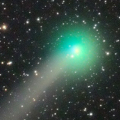
|
It brightened up to 6.0 mag in June (June 13, Marco Goiato). Now it is fading. But it is very bright as 8.1 mag still ow (July 16, Paul Camilleri). It stays observable in good condition for a long time after this.
Date(TT) R.A. (2000) Decl. Delta r Elong. m1 Best Time(A, h)
July 18 12 16.68 10 46.2 0.950 1.051 64 8.1 18:37 (142, 36)
July 25 12 53.56 14 29.2 1.041 1.115 65 8.8 18:41 (145, 33)
|

|
Now it is bright as 8.2 mag (July 16, Paul Camilleri). In the Southern Hemisphere, it stays observable in good condition in the evening sky while the comet will be fading. In the Northern Hemisphere, it is not observable until mid August when the comet will fade down to 12 mag.
Date(TT) R.A. (2000) Decl. Delta r Elong. m1 Best Time(A, h)
July 18 10 5.35 0 21.2 0.702 0.645 38 8.5 18:37 (106, 21)
July 25 11 3.34 -8 33.4 0.637 0.773 49 9.6 18:41 (102, 32)
|
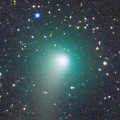
|
Now it is 9.9 mag (July 14, Paul Camilleri). It stays observable in the evening sky until September when it fades down to 12 mag.
Date(TT) R.A. (2000) Decl. Delta r Elong. m1 Best Time(A, h)
July 18 13 3.72 28 50.6 1.977 1.893 70 9.5 18:37 (161, 24)
July 25 13 15.62 24 2.6 2.071 1.942 68 9.8 18:41 (155, 27)
|
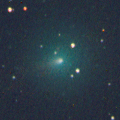
|
Now it is 10.7 mag (July 16, Paul Camilleri). It will brighten up to 8-9 mag from summer to autumn. It will be observable in excellent condition in the Southern Hemisphere. It locates very low around the high light in the Northern Hemisphere.
Date(TT) R.A. (2000) Decl. Delta r Elong. m1 Best Time(A, h)
July 18 13 19.23 -8 56.5 1.249 1.555 86 10.5 18:37 (147, 60)
July 25 13 31.51 -10 32.6 1.266 1.521 82 10.3 18:41 (137, 59)
|

|
Recovered from SWAN images after 24-year blank. It brightened up to 10.2 mag in spring (May 31, Marco Goiato). Now it is fading. But it is still bright as 12.2 mag (July 16, Paul Camilleri). It stays observable for a long time after this until the comet fades out.
Date(TT) R.A. (2000) Decl. Delta r Elong. m1 Best Time(A, h)
July 18 4 29.23 13 12.4 1.974 1.506 48 12.2 5:35 (232, 24)
July 25 4 48.94 13 17.6 1.975 1.540 50 12.4 5:31 (231, 25)
|
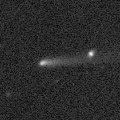
|
Now it is 12.5-13.0 mag (July 5 Michael Jager). It was expected to brighten rapidly up to 9.5 mag in June. But actually, it is fainter than predicted. However, it became very bright as 7.5 mag in SOHO spacecraft images on June 19 (Karl Battams). It is observable in good condition after this while the comet will be fading.
Date(TT) R.A. (2000) Decl. Delta r Elong. m1 Best Time(A, h)
July 18 5 9.41 27 23.8 0.984 0.636 37 12.3 5:35 (229, 7)
July 25 5 25.08 26 52.0 1.100 0.731 40 13.5 5:31 (228, 9)
|

|
It brightened up to 4.7 mag in early May (May 2, Marco Goiato). However, it is fading and getting diffused after that. It had already faded down to 7.3 mag in late May (May 21, Mitsunori Tsumura). It will appear in the morning sky soon. Then it stays observable in good condition.
Date(TT) R.A. (2000) Decl. Delta r Elong. m1 Best Time(A, h)
July 18 6 30.45 25 30.8 2.152 1.234 18 13.3 5:35 (242, -5)
July 25 6 35.11 23 24.9 2.217 1.356 24 13.8 5:31 (241, -1)
|

|
Now it is not visible, fainter than 14.0 mag (July 2, Chris Wyatt).
Date(TT) R.A. (2000) Decl. Delta r Elong. m1 Best Time(A, h)
July 18 2 41.54 25 2.0 6.080 5.813 70 13.7 5:35 (201, 27)
July 25 2 44.70 25 26.1 5.977 5.814 75 13.6 5:31 (196, 28)
|
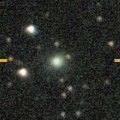
|
Now it is 13.5 mag (July 10, Giuseppe Pappa). It is expected to brighten up to 12 mag from autumn to winter. In the Northern Hemisphere, it stays observable in good condition while the comet will be brightening gradually, but it is hardly observable at the high light. In the Southern Hemisphere, it is not observable for a long time, but it will be observable in good condition after the high light.
Date(TT) R.A. (2000) Decl. Delta r Elong. m1 Best Time(A, h)
July 18 12 1.47 47 25.1 2.844 2.434 56 14.0 18:37 (157, 2)
July 25 12 4.94 43 41.5 2.849 2.375 52 13.9 18:41 (151, 3)
|

|
Now it is 13.9 mag (July 10, Giuseppe Pappa). It stays 14 mag until autumn. In the Southern Hemisphere, it will never be observable again.
Date(TT) R.A. (2000) Decl. Delta r Elong. m1 Best Time(A, h)
July 18 6 41.74 85 11.0 4.259 3.928 64 14.2 5:35 (186,-34)
July 25 8 47.30 85 17.8 4.276 3.967 65 14.3 18:41 (174,-35)
|
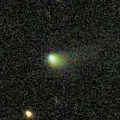
|
Now it is 14.2 mag (July 16, Paul Camilleri). It stays 13-14 mag from 2020 to 2021. It will be unobservable in September.
Date(TT) R.A. (2000) Decl. Delta r Elong. m1 Best Time(A, h)
July 18 12 52.77 7 24.3 3.214 3.093 74 14.3 18:37 (149, 43)
July 25 12 58.76 6 9.7 3.288 3.080 69 14.3 18:41 (141, 41)
|
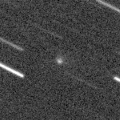
|
Now it is 16.5 mag (July 9, ATLAS-HKO, Haleakala). Small comet. But it will approach to Sun down to 0.47 a.u. in September, and it is expected to brighten up to 11 mag. It stays observable in good condition until late August while the comet will be brightening up to 11 mag.
Date(TT) R.A. (2000) Decl. Delta r Elong. m1 Best Time(A, h)
July 18 1 16.37 29 29.6 0.938 1.343 86 15.1 5:32 (180, 25)
July 25 2 0.15 31 22.7 0.806 1.224 83 14.4 5:31 (184, 23)
|

|
It was expected to brighten very rapidly, and brighten up to 14.5 mag from August to September. However, its current brightness is very uncertain. It could not be detected as fainter than 18.0 mag on June 30 (Charles S. Morris), and fainter than 15.7 mag on July 13 (Sandor Szabo). However, Thomas Lehmann reported it is bright as 15.3 mag on June 25, and Giuseppe Pappa reported as 14 mag on July 10. In the Northern Hemisphere, it stays observable for a long time, although it becomes extremely low in early September. In the Southern Hemisphere, it is not observable until late October.
Date(TT) R.A. (2000) Decl. Delta r Elong. m1 Best Time(A, h)
July 18 6 39.89 86 6.5 1.175 1.190 65 15.1 5:35 (185,-34)
July 25 9 46.49 77 53.8 1.224 1.121 59 14.9 18:41 (166,-31)
|
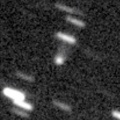
|
Now it is 15.0 mag (June 16, Toshihiko Ikemura, Hirohisa Sato). It will brighten up to 13 mag in 2021. In the Northern Hemisphere, it will be unobservable soon. In the Southern Hemisphere, it stays observable at 15 mag until October.
Date(TT) R.A. (2000) Decl. Delta r Elong. m1 Best Time(A, h)
July 18 13 50.43 -23 38.8 4.433 4.689 98 14.9 18:37 (146, 77)
July 25 13 50.76 -24 8.2 4.503 4.651 92 14.9 18:41 (124, 73)
|
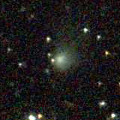
|
Now it is 15.0 mag (July 12, Sandor Szabo). It is expected to be observable at 5-6 mag for a long time from 2022 to 2023. In the Northern Hemisphere, it is not observable at the high light from 2022 summer to 2023 summer. In the Southern Hemisphere, it is only visible in the extremely low sky in summer in 2020. But it will be observable in good condition at the high light.
Date(TT) R.A. (2000) Decl. Delta r Elong. m1 Best Time(A, h)
July 18 17 21.30 51 48.0 8.462 8.700 100 15.0 21:34 (180, 3)
July 25 17 17.24 51 11.0 8.434 8.649 98 15.0 21:02 (180, 4)
|
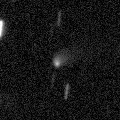
|
Now it is 15.9 mag (July 8, iTelescope Observatory, Siding Spring). It stays 14-15 mag until 2021. In the Southern Hemisphere, it stays observable in good condition for a long time. In the Northern Hemisphere, it is not observable until June in 2021.
Date(TT) R.A. (2000) Decl. Delta r Elong. m1 Best Time(A, h)
July 18 14 34.63 -81 17.3 4.304 4.785 112 15.3 18:51 ( 0, 44)
July 25 14 42.77 -80 30.9 4.311 4.761 110 15.3 18:41 ( 1, 44)
|
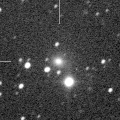
|
It brightened up to 13.5 mag in winter (Dec. 6, Chris Wyatt). Now it is fading slowly. Now it is 15.8 mag (June 14, SONEAR Observatory, Oliveira). In the Southern Hemisphere, it stays observable for a long time. In the Northern Hemisphere, it will appear in the morning sky soon, but it stays low for a while.
Date(TT) R.A. (2000) Decl. Delta r Elong. m1 Best Time(A, h)
July 18 3 24.35 -34 53.1 3.991 4.018 84 15.3 5:35 (279, 64)
July 25 3 25.05 -35 2.9 3.951 4.051 88 15.3 5:31 (277, 69)
|

|
Now it is 15.5 mag (July 9, Sandor Szabo). It stays 15-16 mag for a long time until 2021.
Date(TT) R.A. (2000) Decl. Delta r Elong. m1 Best Time(A, h)
July 18 19 39.98 18 17.4 3.650 4.482 140 15.3 23:52 (180, 37)
July 25 19 29.84 19 0.5 3.664 4.486 139 15.3 23:14 (180, 36)
|

|
Now it is 15.2 mag (July 3, R. Carstens). It will brighten up to 13.5 mag in spring in 2021. In the Southern Hemisphere, it stays observable in good condition for a long time. In the Northern Hemisphere, it is not observable until spring in 2021.
Date(TT) R.A. (2000) Decl. Delta r Elong. m1 Best Time(A, h)
July 18 20 45.28 -65 33.3 3.423 4.199 134 15.4 1:04 ( 0, 60)
July 25 20 14.35 -66 14.2 3.398 4.162 133 15.3 0:06 ( 0, 59)
|
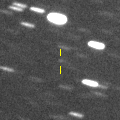
|
Now it is 15.2 mag (July 12, Sandor Szabo). It is observable at 15-16 mag in good condition from June to August.
Date(TT) R.A. (2000) Decl. Delta r Elong. m1 Best Time(A, h)
July 18 19 14.06 -1 53.2 1.078 2.059 158 15.4 23:27 (180, 57)
July 25 19 11.45 -2 41.2 1.086 2.057 156 15.4 22:57 (180, 58)
|
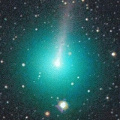
|
It brightened up to 8 mag from March to April. It continued brightening for a while even after the perihelion passage on Mar. 15. But it is fading now. It is still visible visually as 13.0 mag (July 12, Sandor Szabo). However, it has already faded down to 17.0 mag by CCD (July 2, Charles S. Morris). It seems to be a fragment of C/1988 A1 (Liller), like C/1996 Q1 (Tabur) and C/2015 F3 (SWAN).
Date(TT) R.A. (2000) Decl. Delta r Elong. m1 Best Time(A, h)
July 18 12 26.05 14 44.6 2.420 2.202 65 15.5 18:37 (146, 33)
July 25 12 32.88 11 51.1 2.596 2.292 61 15.9 18:41 (138, 33)
|

|
Now it is 15.2 mag (July 9, ATLAS-MLO, Mauna Loa). It is observable at 15-16 mag in 2020. It is observable in excellent condition in the Southern Hemisphere. It locates somewhat low in the Northern Hemisphere.
Date(TT) R.A. (2000) Decl. Delta r Elong. m1 Best Time(A, h)
July 18 18 47.91 -28 49.4 5.769 6.751 163 15.6 23:01 (180, 84)
July 25 18 40.49 -28 31.4 5.825 6.766 156 15.7 22:26 (180, 83)
|
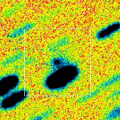
|
Now it is 16.1 mag (June 29, ATLAS-HKO, Haleakala). It brightens up to 13.5 mag in winter. But it is not observable at high light. In the Southern Hemisphere, it stays observable in good condition until autumn when the comet will brighten up to 14 mag. It stays locating very low in the Northern Hemisphere.
Date(TT) R.A. (2000) Decl. Delta r Elong. m1 Best Time(A, h)
July 18 18 6.09 -45 8.4 1.709 2.625 147 15.8 22:19 ( 0, 80)
July 25 17 59.95 -44 9.0 1.718 2.597 142 15.7 21:46 ( 0, 81)
|

|
Now it is 14.9 mag (July 9, Sandor Szabo). It will brighten up to 12 mag in winter in 2022. In the Northern Hemisphere, it stays observable in good condition for a long time. In the Southern Hemisphere, it is not observable until 2021 November.
Date(TT) R.A. (2000) Decl. Delta r Elong. m1 Best Time(A, h)
July 18 0 51.91 58 15.9 5.968 5.869 79 15.8 5:08 (180, -3)
July 25 0 54.16 59 17.4 5.856 5.825 83 15.7 4:43 (180, -4)
|

|
Now it is 15.6 mag (D. L. Feltenberger, N. Paul). It stays 15.5 mag from summer to winter, and observable in good condition. It locates somewhat low in the Southern Hemisphere.
Date(TT) R.A. (2000) Decl. Delta r Elong. m1 Best Time(A, h)
July 18 4 58.10 18 7.2 2.413 1.768 40 16.0 5:35 (234, 16)
July 25 5 16.36 18 38.4 2.391 1.784 42 15.9 5:31 (232, 16)
|

|
Now it is 15.8 mag (July 9, Sandor Szabo). It will stay at 15 mag for a long time from 2021 to 2022. In the Northern Hemisphere, it stays observable in good condition while brightening gradually. In the Southern Hemisphere, it stays locating low for a long time.
Date(TT) R.A. (2000) Decl. Delta r Elong. m1 Best Time(A, h)
July 18 18 1.59 31 4.8 5.544 6.139 121 16.1 22:14 (180, 24)
July 25 17 55.38 30 2.3 5.544 6.110 119 16.1 21:40 (180, 25)
|
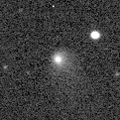
|
It brightened up to 13.8 mag in autumn in 2019 (Sept. 3, Chris Wyatt). Now it is fading slowly. Now it is 15.9 mag (July 8, ATLAS-HKO, Haleakala). In 2020, it stays observable in good condition while the comet will be fading from 16 to 17 mag.
Date(TT) R.A. (2000) Decl. Delta r Elong. m1 Best Time(A, h)
July 18 0 39.52 0 11.5 5.545 5.913 106 16.4 4:56 (180, 55)
July 25 0 38.31 0 30.7 5.480 5.953 113 16.4 4:27 (180, 54)
|
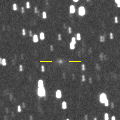
|
Now it is 16.6 mag (July 5, ATLAS-HKO, Haleakala). It will brighten up to 16.5 mag and will be observable in good condition from June to October.
Date(TT) R.A. (2000) Decl. Delta r Elong. m1 Best Time(A, h)
July 18 20 29.40 17 19.5 1.302 2.183 140 16.5 0:46 (180, 38)
July 25 20 25.84 17 26.5 1.276 2.174 142 16.4 0:15 (180, 37)
|

|
Now it is 16.8 mag (July 2, R. Carstens). It brightens up to 16 mag from summer to winter. In the Southern Hemisphere, it is observable in excellent condition. In the Northern Hemisphere, it is not observable until late October.
Date(TT) R.A. (2000) Decl. Delta r Elong. m1 Best Time(A, h)
July 18 22 30.62 -65 31.9 1.192 1.990 128 16.7 2:48 ( 0, 60)
July 25 22 26.98 -67 18.7 1.142 1.941 128 16.6 2:17 ( 0, 58)
|

|
Now it is 16.7 mag (July 1, ATLAS-HKO, Haleakala). It will be observable at 16.5-17 mag from spring in 2020 to summer in 2021.
Date(TT) R.A. (2000) Decl. Delta r Elong. m1 Best Time(A, h)
July 18 18 13.92 19 49.5 3.964 4.714 132 16.6 22:26 (180, 35)
July 25 18 4.13 18 29.5 3.990 4.704 129 16.6 21:49 (180, 37)
|

|
It brightened up to 13.2 mag from spring to autumn in 2019 (June 30, Thomas Lehmann). Now it is fading slowly. It has already faded down to 16.3 mag (July 3, ATLAS-HKO, Haleakala). In the Southern Hemisphere, it stays observable for a long time. In the Northern Hemisphere, it stays low for a long time.
Date(TT) R.A. (2000) Decl. Delta r Elong. m1 Best Time(A, h)
July 18 23 56.58 -30 35.9 3.691 4.347 124 16.6 4:13 (180, 85)
July 25 23 50.66 -30 45.8 3.651 4.386 131 16.6 3:40 (180, 86)
|
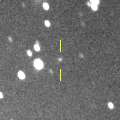
|
Now it is 15.9 mag (Apr. 24, J. Drummond). It is expected to brighten up to 13 mag in 2022. In 2020, it is observable in excellent condition in the Southern Hemisphere. In the Northern Hemisphere, it is not observable. It will be observable from autumn to winter, but it locating extremely low.
Date(TT) R.A. (2000) Decl. Delta r Elong. m1 Best Time(A, h)
July 18 7 19.38 -25 36.2 7.564 6.914 47 16.8 5:35 (292, 14)
July 25 7 25.01 -25 48.6 7.523 6.874 47 16.8 5:31 (289, 18)
|

|
Now it is 17.0 mag (July 12, ATLAS-HKO, Haleakala). It will brighten up to 14.5 mag from spring to summer in 2021. In the Southern Hemisphere, it stays observable in excellent condition for a long time. In the Northern Hemisphere, it is observable in good condition in 2020, however, it will be unobservable in 2021.
Date(TT) R.A. (2000) Decl. Delta r Elong. m1 Best Time(A, h)
July 18 23 13.51 6 7.5 3.221 3.873 123 17.0 3:30 (180, 49)
July 25 23 8.78 4 39.3 3.075 3.824 131 16.8 2:58 (180, 50)
|
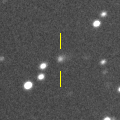
|
Now it is 17.1 mag (July 2, ATLAS-MLO, Mauna Loa). It stays observable at 16-17 mag from 2020 to 2021. It locates somewhat low in the Northern Hemisphere.
Date(TT) R.A. (2000) Decl. Delta r Elong. m1 Best Time(A, h)
July 18 11 11.86 -14 49.6 7.030 6.599 61 16.9 18:37 (103, 43)
July 25 11 16.50 -14 46.8 7.121 6.603 55 17.0 18:41 ( 98, 37)
|
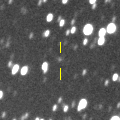
|
Now it is 17.0 mag (June 23, A. Diepvens). It will be observable at 16.5-17 mag from 2020 to 2021. In the Southern Hemisphere, it is not observable until summer in 2021.
Date(TT) R.A. (2000) Decl. Delta r Elong. m1 Best Time(A, h)
July 18 1 56.44 71 55.6 6.439 6.158 69 17.0 5:35 (183,-17)
July 25 1 49.95 72 35.3 6.359 6.145 73 17.0 5:31 (181,-18)
|

|
It will pass the perihelion in 2021, and it was predicted to be observable at 17-18 mag from 2020 to 2022. However, it has not been observed at all since 2015. It was not detected, fainter than 20.5 mag, in 2017 May (Werner Hasubick).
Date(TT) R.A. (2000) Decl. Delta r Elong. m1 Best Time(A, h)
July 18 20 30.15 -22 17.4 4.942 5.947 170 17.2 0:47 (180, 77)
July 25 20 27.34 -22 22.9 4.922 5.936 176 17.2 0:17 (180, 77)
|

|
Now it is 18.7 mag (July 13, ATLAS-MLO, Mauna Loa). It is expected to brighten up to 15 mag from October to November, and it will be observable in excellent condition.
Date(TT) R.A. (2000) Decl. Delta r Elong. m1 Best Time(A, h)
July 18 23 51.96 -33 14.4 1.116 1.897 125 17.4 4:08 (180, 88)
July 25 23 59.63 -33 56.5 1.030 1.848 129 17.2 3:48 (180, 89)
|

|
It brightened up to 7.7 mag in June in 2018 (June 19, Juan Jose Gonzalez). Now it is fading. It has already faded down to 16.9 mag (Apr. 22, J. Drummond). In the Southern Hemisphere, it stays observable for a long time until the comet will fade out. It will be observable in good condition after late August also in the Northern Hemisphere.
Date(TT) R.A. (2000) Decl. Delta r Elong. m1 Best Time(A, h)
July 18 6 21.51 -10 4.5 7.943 7.169 37 17.3 5:35 (270, 17)
July 25 6 24.58 -10 3.8 7.961 7.222 40 17.3 5:31 (267, 22)
|
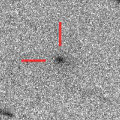
|
Now it is 18.3 mag (June 28, Jean-Benoit de Vanssay). It brightens up to 16 mag in September. It is observable in good condition in the Northern Hemisphere. It locates low in the Southern Hemisphere.
Date(TT) R.A. (2000) Decl. Delta r Elong. m1 Best Time(A, h)
July 18 3 33.25 17 25.3 1.449 1.294 60 17.6 5:35 (217, 29)
July 25 4 0.31 19 2.0 1.425 1.277 60 17.3 5:31 (217, 27)
|
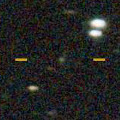
|
Now it is 17.1 mag (July 6, ATLAS-MLO, Mauna Loa). It became brighter than orignally predicted. It stays observable at 17 mag in good condition until autumn.
Date(TT) R.A. (2000) Decl. Delta r Elong. m1 Best Time(A, h)
July 18 13 19.15 -13 6.6 1.917 2.133 87 17.3 18:37 (143, 64)
July 25 13 29.11 -14 11.3 1.979 2.122 83 17.3 18:41 (132, 62)
|

|
First return of a new periodic comet which brightened up to 17.5 mag in 2012. Now it is 17.6 mag (June 30, Hidetaka Sato). It stays observable at 17 mag in good condition from summer to winter. It locates somewhat low in the Southern Hemisphere.
Date(TT) R.A. (2000) Decl. Delta r Elong. m1 Best Time(A, h)
July 18 3 25.84 22 45.7 2.603 2.286 60 17.5 5:35 (212, 25)
July 25 3 38.34 23 57.4 2.539 2.292 64 17.4 5:31 (209, 25)
|

|
Now it is 17.4 mag (July 13, ATLAS-MLO, Mauna Loa). It will brighten up to 14 mag in November, and will be observable in excellent condition.
Date(TT) R.A. (2000) Decl. Delta r Elong. m1 Best Time(A, h)
July 18 0 55.92 -33 5.5 1.273 1.906 112 17.8 5:12 (180, 88)
July 25 1 13.58 -33 44.9 1.175 1.838 113 17.5 5:02 (180, 89)
|

|
It brightened up to 12-13 mag from 2018 to 2019. Now it is fading. It has already faded down to 17.0 mag (June 24, P. Camilleri, H. Williams, M. Al-Bussadi). In the Southern Hemisphere, it stays observable in good condition for a long time. It will never be observable after this in the Northern Hemisphere.
Date(TT) R.A. (2000) Decl. Delta r Elong. m1 Best Time(A, h)
July 18 9 31.36 -57 1.5 5.936 5.862 80 17.5 18:37 ( 41, 38)
July 25 9 35.41 -56 39.1 6.035 5.909 78 17.6 18:41 ( 41, 34)
|
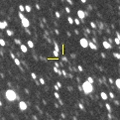
|
Sam Deen pointed out that it brightened in outburst twice in 2017 and 2019. It was observed at 20-21 mag in 2017. Then it became fainter than 22.9 mag in 2018 summer (Aug. 29, Sam Deen). However, it brightened up to 17.2 mag in 2019 spring (Mar. 25, B. T. Bolin). Then it faded again down to 19.9 mag (May 29, Toshihiko Ikemura, Hirohisa Sato). Now it is 18.1 mag (July 9, J. Jahn). It is predicted to stay observable at 18 mag for a long time from 2019 to 2021. But actually, it may be fainter than this ephemeris.
Date(TT) R.A. (2000) Decl. Delta r Elong. m1 Best Time(A, h)
July 18 18 44.63 -22 22.3 6.727 7.712 164 17.6 22:58 (180, 77)
July 25 18 41.00 -22 57.2 6.770 7.717 157 17.6 22:27 (180, 78)
|

|
Now it is 17.2 mag (July 9, ATLAS-MLO, Mauna Loa). It will brighten up to 15.5 mag in early 2021. In 2020, it stays observable at 17 mag until November in the Southern Hemisphere. In the Northern Hemisphere, it will be unobservable soon. Then it stays unobservable until 2021 June.
Date(TT) R.A. (2000) Decl. Delta r Elong. m1 Best Time(A, h)
July 18 14 0.27 -28 55.6 2.633 3.015 102 17.7 18:37 (140, 82)
July 25 14 3.25 -28 44.1 2.672 2.959 96 17.7 18:41 (116, 78)
|
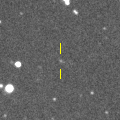
|
Now it is 17.5 mag (June 28, Ken-ichi Kadota). It stays 18 mag from 2019 to 2020.
Date(TT) R.A. (2000) Decl. Delta r Elong. m1 Best Time(A, h)
July 18 21 14.83 -5 2.1 3.652 4.587 153 17.7 1:32 (180, 60)
July 25 21 11.70 -5 19.0 3.618 4.589 160 17.7 1:01 (180, 60)
|

|
Now it is 17.4 mag (June 24, Martin Masek). It will be fading slowly after this. It is observable in good condition in the Northern Hemisphere. In the Southern Hemisphere, it is observable in the extremely low sky only in 2021 spring.
Date(TT) R.A. (2000) Decl. Delta r Elong. m1 Best Time(A, h)
July 18 12 41.78 45 58.5 9.367 8.957 63 17.7 18:37 (163, 6)
July 25 12 43.90 45 5.9 9.440 8.971 59 17.8 18:41 (157, 5)
|

|
It has not been observed yet in this apparition. It will brighten up to 17.5 mag in autumn. It is observable in excellent condition in the Southern Hemisphere. It locates very low in the Northern Hemisphere.
Date(TT) R.A. (2000) Decl. Delta r Elong. m1 Best Time(A, h)
July 18 23 31.27 -21 36.6 2.426 3.163 128 17.8 3:48 (180, 76)
July 25 23 32.43 -23 3.5 2.359 3.158 134 17.7 3:21 (180, 78)
|
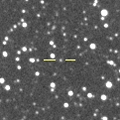
|
Now it is 16.9 mag (July 3, ATLAS-MLO, Mauna Loa). It is observable at 17-18 mag in good condition in 2020 summer.
Date(TT) R.A. (2000) Decl. Delta r Elong. m1 Best Time(A, h)
July 18 19 27.35 31 51.5 8.275 8.922 126 17.8 23:40 (180, 23)
July 25 19 23.14 32 3.9 8.272 8.916 126 17.8 23:08 (180, 23)
|

|
Now it is 18.2 mag (Apr. 27, iTelescope Observatory, Siding Spring). It stays 17 mag for a long time until 2027. It is observable in good condition in the Southern Hemisphere. It is not observable in the Northern Hemisphere.
Date(TT) R.A. (2000) Decl. Delta r Elong. m1 Best Time(A, h)
July 18 9 38.26 -42 50.6 12.480 12.145 68 17.8 18:37 ( 59, 36)
July 25 9 40.30 -42 55.8 12.514 12.126 65 17.8 18:41 ( 56, 31)
|
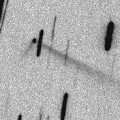
|
Main-belt asteroid. But it showed a straight tail like a comet in 2019. In 2020, it brightens up to 16.5 mag and stays observable in good condition from September to October.
Date(TT) R.A. (2000) Decl. Delta r Elong. m1 Best Time(A, h)
July 18 0 30.41 14 13.8 1.652 2.121 102 18.0 4:46 (180, 41)
July 25 0 35.19 14 2.0 1.587 2.137 108 17.9 4:24 (180, 41)
|

|
Now it is 17.9 mag (July 14, ATLAS-MLO, Mauna Loa). It will be fainter than 18 mag soon.
Date(TT) R.A. (2000) Decl. Delta r Elong. m1 Best Time(A, h)
July 18 13 35.30 -7 29.4 1.921 2.162 89 17.9 18:37 (156, 61)
July 25 13 45.82 -8 30.3 2.006 2.174 85 18.1 18:41 (145, 59)
|

|
Fragment of C/1844 Y1 (Great Comet). It brightened up to 7.0 mag in late March ((Mar. 30, Charles S. Morris). But the nucleus was split into some fragments, and it faded out after that. It was 9.1 mag in mid May (May 17, Sandor Szabo). It approached to Sun down to 0.25 a.u. on May 31. In the Northern Hemisphere, it is not observable after this. In the Southern Hemisphere, it is appearing in the morning sky, but it locates extremely low.
Date(TT) R.A. (2000) Decl. Delta r Elong. m1 Best Time(A, h)
July 18 6 18.86 2 6.2 2.030 1.246 29 19.0 5:35 (260, 11)
July 25 6 31.63 1 36.6 2.136 1.379 31 19.5 5:31 (258, 14)
|
|
![]()
 C/2019 F1 ( ATLAS-Africano )
C/2019 F1 ( ATLAS-Africano ) C/2017 K2 ( PanSTARRS )
C/2017 K2 ( PanSTARRS ) C/2020 F5 ( MASTER )
C/2020 F5 ( MASTER ) C/2018 F4 ( PanSTARRS )
C/2018 F4 ( PanSTARRS ) C/2019 K7 ( Smith )
C/2019 K7 ( Smith ) C/2020 J1 ( SONEAR )
C/2020 J1 ( SONEAR ) 115P/Maury
115P/Maury C/2019 Y1 ( ATLAS )
C/2019 Y1 ( ATLAS ) C/2017 U7 ( PanSTARRS )
C/2017 U7 ( PanSTARRS ) 17P/Holmes
17P/Holmes C/2019 L3 ( ATLAS )
C/2019 L3 ( ATLAS ) 84P/Giclas
84P/Giclas C/2018 U1 ( Lemmon )
C/2018 U1 ( Lemmon ) C/2017 B3 ( LINEAR )
C/2017 B3 ( LINEAR ) 257P/Catalina
257P/Catalina 162P/Siding Spring
162P/Siding Spring C/2017 Y2 ( PanSTARRS )
C/2017 Y2 ( PanSTARRS ) C/2018 A6 ( Gibbs )
C/2018 A6 ( Gibbs ) C/2019 T4 ( ATLAS )
C/2019 T4 ( ATLAS ) C/2019 T2 ( Lemmon )
C/2019 T2 ( Lemmon ) C/2019 C1 ( ATLAS )
C/2019 C1 ( ATLAS ) C/2019 T3 ( ATLAS )
C/2019 T3 ( ATLAS ) C/2014 F3 ( Sheppard-Trujillo )
C/2014 F3 ( Sheppard-Trujillo ) 156P/Russell-LINEAR
156P/Russell-LINEAR C/2016 M1 ( PanSTARRS )
C/2016 M1 ( PanSTARRS ) 304P/Ory
304P/Ory 278P/McNaught
278P/McNaught P/2020 M2 ( Lemmon )
P/2020 M2 ( Lemmon ) C/2020 M3 ( ATLAS )
C/2020 M3 ( ATLAS ) C/2017 M4 ( ATLAS )
C/2017 M4 ( ATLAS ) C/2017 K5 ( PanSTARRS )
C/2017 K5 ( PanSTARRS ) 28P/Neujmin 1
28P/Neujmin 1 P/2019 LD2 ( ATLAS )
P/2019 LD2 ( ATLAS ) C/2010 U3 ( Boattini )
C/2010 U3 ( Boattini ) 254P/McNaught
254P/McNaught A/2019 O3
A/2019 O3 C/2019 E3 ( ATLAS )
C/2019 E3 ( ATLAS ) (6478) Gault
(6478) Gault 87P/Bus
87P/Bus C/2019 Y4 ( ATLAS )
C/2019 Y4 ( ATLAS )![]()









































